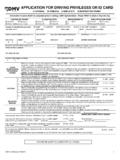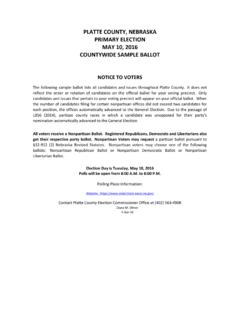Transcription of Michigan Department of State Bureau of Elections
1 Michigan Department OF State Bureau of Elections September 2016 Michigan ballot Production Standards TABLE OF CONTENTS I. Introduction ..3 II. Paper and Ink Specifications ..3 III. Technical Reminders ..4 IV. Consolidated Election Dates ..4 V. Primary Elections ..5 VI. Election Types and ballot Headings ..6 VII. ballot Instructional Language ..11 VIII. Instructional Modification Notes ..14 IX. Closed Presidential Primary ..15 X. Two Page Ballots ..17 XI. Presentation of ballot Labels and Office and Proposal Divisions ..18 XII. Presentation of Political Party Vignettes.
2 19 XIII. Presentation of Office Titles ..20 XIV. Presentation of Candidate Names, Political Party Designations, Voting Targets, Write-In Positions and the Maximum Number of Votes Allowed ..23 XV. Judicial Office Designations, Districts and Divisions ..24 XVI. Full Terms and Partial Terms (Vacancies) ..26 XVII. Presentation of ballot Proposals ..27 XVIII. Ballots Containing a Recall ..28 XIX. Candidate Name Rotations ..29 XX. Sample Ballots ..31 XXI. Summary Technical Standards ..32 APPENDIX A Political Party Vignettes ..41 APPENDIX B - Sample Ballots ..43 3 I. Introduction The integrity of Michigan s Elections system is wholly dependent on the performance of the voting equipment used to support the system.
3 Given the fact that optical scan technology relies on a physical ballot , the functionality of the voting equipment is greatly compromised if the ballots are not prepared in conformance with all applicable laws, rules and technical standards. As a consequence, the standards detailed in this document are compulsory and must be observed by vendors and election officials when preparing ballots for the administration of all Michigan Elections . Our goal is to ensure 1) uniform conformance with all applicable provisions of Michigan election law and the Rules Promulgated for the Administration of Electronic Voting Systems and 2) that all ballots prepared for an election will properly interface with the optical scan tabulation equipment and AutoMARK Voter Assist Terminals.
4 While the majority of the standards included in this document are based on law and promulgated rules, a portion of the information is voting system specific. To assist with the understanding of the ballot production standards, ballot samples are provided in APPENDIX B. The samples reflect a variety of Michigan election types including but not limited to: 1) a Primary held in conjunction with a Special General Election 2) a General Election 3) Closed Presidential Primary Election 4) a Special Election 5) a City Primary 6) various Recall ballots and 7) a single party Special Primary.
5 Chapter XXI of this document addresses the voting system specific technical standards. The technical standards included in this document are presented as a summary of the ballot production standards which are more comprehensively addressed in separate documents which are on file with the Michigan Department of State , Bureau of Elections . Copies of the full technical standards may be obtained by contacting the Bureau of Elections at 1-800-292-5973 or While copies of the full ballot production standards will be provided upon request, all questions regarding the technical standards should be directed to the manufacturer of the voting system involved.
6 II. Paper and Ink Specifications All paper and ink specifications provided by the voting equipment manufacturers must be closely observed. Special attention must be paid to perforation, score and fold specifications. Please refer to the manufacturer s technical standards for additional information. Vendors who produce ballots for use with the optical scan voting systems should exercise special care to ensure that the ballots are fully compatible with the AutoMARK Voter Assist Terminals. As certain ballot production methods can result in the pooling of ink on the ballots when marked with an AutoMARK terminal, the conduct of appropriate testing procedures to avoid such problems is extremely important.
7 If left unchecked, the ink-pooling problem can lead to optical scan tabulator failures. 4 III. Technical Reminders Do not place thick bold lines, folds or score lines near ovals or arrows. ID bars and channel code bars must not touch the ballot cut marks. Where shading is required, the lightest shade of gray must be used. Avoid print washout (skips in ink or faded ink). When cutting ballots, take appropriate measures to ensure that the cut is not skewed. When perfing ballots, take appropriate measures to ensure that the perforation is not skewed. All tabulators and AutoMARK terminals must be tested prior to each election to ensure that the equipment will accept ballots that contain a perforated ballot stub.
8 Ballots may not exceed 22 inches in length, without the ballot stub. Font size should not be smaller than 8 point. Consistent application of font is required, all proposal text shall be all the same point size, candidates shall all be the same point size, all headers shall be the same point size, etc. The use of sans serif fonts is required. (Disabilities communities request the use of fonts which do not contain tails.) The use of Helvetica and Helvetica Narrow is recommended for Unity users; Arial and Arial Narrow is recommended for GEMS and WinEDS users. IV. Consolidated Election Dates The conduct of all federal, State , county, city, township, village and school Elections are restricted to these dates each year: the first Tuesday after the first Monday in May, August and November.
9 Exceptions are provided for: special Elections called under the State Constitution by the Governor and the State Legislature; and school districts, intermediate school districts and community college districts that wish to present a millage proposal, bond proposal or a proposal to borrow funds on a date other than one of the fixed election dates. (Certain limitations apply.) 5 V. Primary Elections The following rules must be observed when determining if a primary must be held within a jurisdiction. (See: MCL and MCL ) Partisan Offices - A primary must be held if there is a "contest" within a political party ( , two or more candidates of the same political party file for the same office).
10 In this case, all of the offices are shown on the ballot . Note the following: If a primary must be held because of a contest under one of the parties qualified to appear on the primary ballot and at least one filing for an office is received from a candidate affiliated with the other party qualified to participate in the primary both parties are placed on the primary ballot and general election ballot . All offices are shown for both parties. If a primary must be held because of a contest under one of the parties qualified to appear on the primary ballot but no filings are received from candidates affiliated with the other party qualified to participate in the primary the party for which no filings are received does not appear on the primary ballot or the general election ballot .















